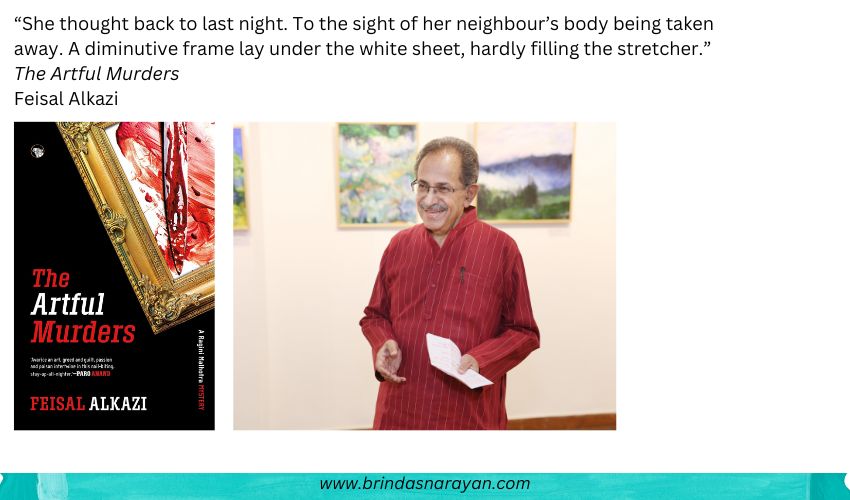
A Crime Thriller That Pierces Delhi’s Pretensions
If you’re a fan of the Japanese thriller writer, Keigo Higashino, I would strongly recommend The Artful Murders. Like some of the standout works of the Japanese master, this depicts a gritty, layered city, populated by a plethora of characters, all of whom are intertwined in sordid or salubrious ways. In a bracing departure from hardboiled crime noir, Alkazi’s detective is the feisty Mrs. Ragini Malhotra, a 62-year-old widow who trains her all-seeing female gaze into the dark corners of her neighborhood and beyond.
Her journey across Delhi’s labyrinthine social map – from the seemingly placid Greater Kailash II to the airless quarters of an auto driver and his mates, from culture-making spots like Triveni Kala Sangam and the India Habitat Centre to the teeming Pul Bangash – is sparked off by the death of ‘Masala Dosa Aunty.’ Mrs. Krishnamurthi, a lonesome woman who tended to her plants and fed kids with ‘Madrasi snacks’ is carted out of her home on a stretcher. Her death might have been dismissed if nosy Ragini with her super-sharp smell hadn’t inhaled the bitter almond vapors of potassium cyanide inside Mrs. K’s idli batter.
Ragini, led by her instinct for human peculiarities, is also attuned to her limitations. Like other wise women, she does what women often do best: she collaborates. While hounding a killer, she’s naturally wary about whom she trusts. She ropes in Premlata Puri, a private investigator who usually handles premarital or extramarital cases. She also bounces her thoughts off a circle of college friends, while filling in the police on her breakthroughs. She doesn’t treat the police – like many famous male detectives do – as fumbling dimwits. She even solicits the help of Raunaq, the auto driver, who drops her grandchild to school. Eventually, it’s not just her investigations that help crack the puzzle. Like in any complex human endeavor, collective efforts topple personal smarts. Though Malhotra’s X-ray vision ensures they see through various camouflages.
That’s another theme that runs through the book: the various costumes and masks that characters don, to both slip in and out of socially-constructed identities. Some like the actor Shadaab, and the private detective Premlata, do this literally: wearing diverse costumes to enter alter-personas or to stalk targets. Others, however, play-act more subtly. On the sly, like the gay Rudy’s secret lover, a “mousey CA” whose social façade includes a wife and three kids. Or Ruksana Begum, who exudes an old-world sophistication to cover her new-world greed.
Even Ragini or Raags enjoys flitting between the multitudes that inhabit her being – from a flirty college self to a protective grandmotherly avatar, from a gritty detective who’s undeterred by a stalking killer to a gossipy neighbor, or just an old lady – who panics as anyone would – when the lift stalls between floors.
As an astute theatre practitioner, Alkazi uses liminal spaces and moments to foster a quiet dread: waiting for a metro, riding a lift in an empty building, observing a blank wall space in Mrs. K’s dimly lit living room, rifling through fake and real Husains inside a sighing haveli.
It’s not a work that’s confined to the upmarket GK-II. It wanders frequently into other spaces – like the small room shared by Raunaq and Rudy. Raunaq might not be as well-heeled as his passengers, but he exudes a tolerance for his roommate that might evade upper-class conservatives. Rudy is gay and is in love with his muscly partner Pratap, and though Raunaq is into women, he’s indifferent to his roommate’s sexual orientation.
This is an India, where unlikely connections are forged, like that between Mrs. Malhotra and the auto driver. Or between the Hindi-speaking Raunaq and English-knowing Rudy. Transactional exchanges are overlaid by emotional ones. Rudy and Pratap share an idyllic “love” – a feeling that eludes the glamorous, Page-3 persona, Shobana. Who hires a potential “mistress” to snag her husband, a deft and ruthless idea that she gleans on a visit to Japan.
Delhi is not just a place where this novel is set, but a character seething with possibilities and contradictions. Like the metro that snakes through its innards, the city swallows its riders and spits them out, uncaring about their befores and afters. The great unifier across diversities – of class, gender, caste, sexuality – is Death. It’s telling that the long-distance cab driver Pratap’s murder is splashed all over the media, while upper-class Mrs. K in GK-II is snuffed out quietly. Inevitably, everything is interlinked, but perhaps that’s not the point.
Maybe it’s about how everyone – whether embedded in clammy tenement houses, in a bustling marketplace, or a snooty, art-loving circle – is not just eventually alone, but resides first and foremost, inside their heads. The simultaneous atomization and crowding fostered by cities occasionally erupt in violence or crime. At least on stage, and in novels like Alkazi’s, a crafty neighborhood detective patches things over. It’s less easy to rein in such forces In Real Life. It’s best then to artfully escape the mess by ducking into these pages.
As an aside, for Japanophiles, the book is embedded with Japanese nuggets. Not just the commonly bandied ikigai or wabi-sabi, but the sheer theatricality that’s woven into Japanese life. For instance, how the geisha manipulate clients, or how the gaiko (senior geisha) tutors the maiko (apprentice). Or kishotenketsu, a four-part story structure that the novel deploys, a departure from the three-act structure of most Western works.
About the Author: Feisal Alkazi is a theatre stalwart, an educationist, and activist. He’s also a prolific author and documentary filmmaker. As the son of Ebrahim Alkazi (known as the “father of modern Indian theatre”) and Roshen Alkazi (a costume designer, art gallery owner, and sister of Alyque Padamsee), storytelling chops are clearly braided into his being.
References:
Feisal Alkazi, The Artful Murders: A Ragini Malhotra Mystery, Speaking Tiger, 2025




